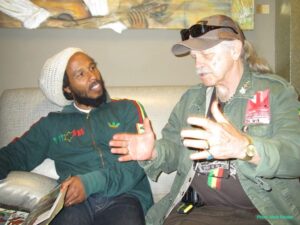It’s (Not) The End of the World as We Know It

Originally appeared in “Rising to the Challenge: The Campaign for Johns Hopkins“
“‘Apocalypse’ is something a lot of people have walked right by, but never seen,” says Krieger School professor and historian Stuart “Bill” Leslie of the psychedelic mural that envelops Levering Hall’s second floor. But it’s emerging from the shadows after a recent restoration of the artwork, originally painted in 1969 by acclaimed muralist Robert Hieronimus, PhD.
Funding for the “Apocalypse” facelift was provided by the Joseph and Harvey Meyerhoff Family Charitable Funds, Johns Hopkins University, and Zohara Hieronimus. Bob Hieronimus oversaw the project, which was carried out by a team of graduate students from the Maryland Institute College of Art and Hopkins. The restoration ensures that this thought-provoking conduit to a part of Hopkins history lives on for future generations.
The “Apocalypse” story begins more than a decade before Hieronimus began painting the mural. In 1953, Chester Wickwire arrived to lead Johns Hopkins’ branch of the YMCA, headquartered in Levering Hall. A social activist deeply engaged in Baltimore’s civil rights movement, Wickwire didn’t distinguish between his work in the community and his post at Hopkins. He brought speakers, artists, and musicians to perform for and spark debate among students on Levering’s second floor, first nicknamed the “Room at the Top” and, later, “Chester’s Place” in Wickwire’s honor.
“That was the one place on campus where students could really talk” about issues ranging from race relations to women’s rights to the Vietnam War, Leslie says. Wickwire sought an artist who could provide artwork that complemented his vision for Levering, and he found one very close to home.
“Hieronimus was active in local civil rights causes, and that appealed to Wickwire and what he was trying to create,” says Ella Rogers-Fett, a Krieger School senior and history major who spent much of last summer researching Wickwire’s papers. “The mural would be a fusion of the 1960s and 1970s art scene with a political conscience.”
Over the course of several months, Hieronimus created the mural. Originally slated to cover just one wall, the mural grew to cover the entire room, including its doors, the ceiling, and the stairwell. “Apocalypse” tells the story of human history in a dizzying array of colors and symbols drawn from mythology and diverse religions.
Learn about Hieronimus’ favorite parts of the mural, and what they mean, in his own words.
Rogers-Fett visited the mural for the first time as part of Leslie’s winter Intersession course in 2015 and says she and many of her classmates were inspired upon learning about the mural’s relationship to a history of student activism at Hopkins. That inspiration resulted in a petition her fellow students started to encourage Hopkins to divest itself from carbon-related stocks to reduce its environmental impact. Recently, Rogers-Fett visited the mural space for a meeting of social justice groups organized by the Center for Social Concern, a division of Homewood Student Affairs.
“I like the idea that student activists of today are meeting there to advance important issues,” says Rogers-Fett, who serves as a co-director of the student-run Sexual Assault Resource Unit. “We’re continuing the spirit of ‘Apocalypse.'”
Hieronimus, who calls the mural his “favorite, hardest, best, and deepest work,” insists that “Apocalypse” isn’t a depiction of the apocalypse as it’s described in the Book of Revelation.
“It’s not the end of the world. It’s the end of a cycle” of civilization rising, falling, then rising again, he says.
“It’s a Homewood campus landmark,” says Justin Williams, a senior lecturer in the Whiting School’s Department of Geography and Environmental Engineering. Williams has worked with Hieronimus to restore several of the artist’s murals around Baltimore, including “Apocalypse.” “It’s a destination site for anyone who is interested in mural art, symbolism, and the history of the university.”
Leslie, who has been tasked with writing a new history of the university, says that, more than anything else, “Apocalypse” represents a call to action. For that reason, he plans to include it in his book.
“‘Apocalypse’ is a challenging space. Bob meant for this mural to make people uncomfortable,” Leslie says. “He meant for people to think about how a university isn’t just labs and seminars and exams. The mural is deliberately provocative, and in some ways, it’s more provocative now than it was then.”
Learn more about Apocalypse and the history of social activism at Hopkins during Leslie’s Alumni Weekend talk on April 8.



